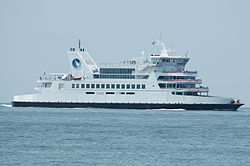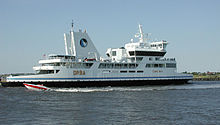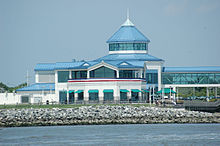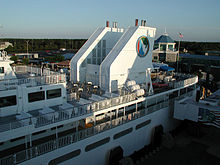- Cape May
-
Cape May – Lewes Ferry 
M.V. Twin Capes near the Cape May, New Jersey terminal on July 4, 2005.Locale North Cape May, New Jersey and Lewes, Delaware Waterway Delaware Bay Transit type Passenger/automobile ferry Operator Delaware River and Bay Authority Began operation July 1, 1964 System length 17 miles (27 km) No. of lines 1 No. of vessels 5 No. of terminals 2 Website http://www.capemaylewesferry.com/ http://www.capemaylewesferry.com/ The Cape May – Lewes Ferry is a ferry system that traverses a 17-mile (27 km) crossing of the Delaware Bay to connect Cape May, New Jersey with Lewes, Delaware. The ferry doubles as a section of U.S. Route 9.
Contents
The system
The Cape May – Lewes Ferry, operated by the Delaware River and Bay Authority (DRBA), consists of five ferry vessels and two terminal facilities. Its operations are based at its Cape May terminal, which is actually located in North Cape May, on the north shore of the Cape May Canal.
The five vessels in the fleet carry both vehicles (passenger cars, buses, RVs, tractor trailers, motorcycles, and bicycles are all common) and foot passengers. Each has a capacity of about 100 cars, which sells out in advance during the popular summer weekends (although passenger capacity usually does not). Advance reservations are accepted.
The ferry trip takes approximately 80 minutes[1] and provides a view of three lighthouses: the Cape May Light in New Jersey, and the Harbor of Refuge Light and Delaware Breakwater East End Light near Lewes.
The ferry's terminal buildings were substantially overhauled in 2000-2001. Cape May received a brand-new terminal to replace the existing structure, built in 1988. The Lewes terminal, also built in 1988, was expanded and renovated at the same time. Both terminals now feature unique, recognizable "towers," which contain elevators and staircases connecting the terminal buildings to glass-enclosed walkways. The walkways allow foot passengers to board the vessel directly on the second deck, avoiding vehicles driving onto the car deck below.
The terminal buildings feature gift shops, food courts, bars, restaurants, ticketing and information booths, and occasional history or art exhibits.
The fleet
The original fleet of steamships were purchased in 1964 from the defunct Little Creek-Cape Charles Ferry in Virginia, replaced by the Chesapeake Bay Bridge-Tunnel. These ships were replaced beginning in 1974 with new, diesel-powered vessels. The three original vessels of the new fleet, the M.V. Delaware, M.V. Twin Capes, and M.V. New Jersey, were supplemented by the M.V. Cape Henlopen (originally the M.V. New Del) in 1981 and the M.V. Cape May in 1985. Although these five vessels currently differ in external appearance, they were originally designed and built to identical specifications. Renovation projects in the mid- to late-1990s radically altered the shapes and appearances of the fleet. However, the vessels were only rebuilt from the hull up, meaning that their hulls and engines remain identical.
Each vessel consists of an open car deck situated atop a hull that is low to the water. Because of the ships' shallow displacements, the ships appear almost barge-like, sitting directly atop the water, from a distance. The ships were originally built with two decks atop the car deck—the second deck consisting of a gift shop, snack bar, and interior and exterior seating areas, and the third deck consisting of outdoor seating areas. Historically, an interior crew room was situated on the third deck, and a pilot house was on the fourth deck. Subsequent renovations changed these plans for some of the vessels.
Each vessel can hold 100 cars and 1,000 passengers. All have a length of 320 feet (98 m) and a breadth of 68 feet (21 m), a displacement of at least 2100 tons, a maximum draft of 7 feet (2.1 m), two 4,000 horsepower (3,000 kW) diesel engines, and a top speed of 16 knots (30 km/h) (18 mph).[2]
M.V. Delaware
The M.V. Delaware was one of the original three vessels of the new 1970s fleet, and it was also the first vessel in the fleet to be completely refurbished. A renovation in 1994 added "shark's fin" stacks to the vessel as well as an interior deli and bar on the third deck. The second and third decks were extended over the car deck in this renovation to provide for more seating. A second renovation at the end of the 1990s reconfigured the interior spaces on the second deck. Her sister ships are the M.V. Cape May and M.V. Twin Capes.
M.V. Twin Capes
The M.V. Twin Capes, one of the original three vessels of the 1974 fleet, achieved superstar status in the fleet upon its $27 million renovation in 1996. While other vessel renovations maintained the original structures above the ships' hulls, the renovation of the Twin Capes saw the original vessel's entire superstructure above the car deck removed and replaced. The vessel was then marked as a miniature cruise ship, complete with an elevator, a sweeping interior staircase, interior areas on four different decks, an enlarged gift shop, a food court with a brick pizza oven, four different bars, and a buffet restaurant in a two-deck-tall, glass-enclosed room. Although the buffet was shut down in 2000 after U.S. Food and Drug Administration inspectors found numerous violations in the galleys of all five vessels, the ship remains an attraction. Her sister ships are the M.V. Cape May and M.V. Delaware. Due to decreasing ridership, the DRBA announced in July 2010 that the M.V. Twin Capes was up for sale.[3] It is the second boat to be put up for sale after the M.V. Cape May in 2007. It has not yet been sold and the DRBA stated that it will remain in use until sold. Both Canadian and Nigerian ferry operators expressed interest in purchasing both it and the Cape May.
M.V. Cape May
 The M.V. Cape May ready to dock at the Cape May, New Jersey, terminal on August 8, 2002. As of 2007, the DRBA removed the M.V. Cape May from service.
The M.V. Cape May ready to dock at the Cape May, New Jersey, terminal on August 8, 2002. As of 2007, the DRBA removed the M.V. Cape May from service.
The M.V. Cape May, the newest vessel of the fleet, was refurbished in 1998 in a $20 million project that retained the original superstructure and added deck extensions and a new fourth deck. The renovation added a fourth-deck buffet restaurant, bars, an enlarged gift shop, an elevator, and additional interior seating. In 2007, in order to help close an operating deficit, the DRBA removed the M.V. Cape May from service and announced that the vessel was up for sale. The vessel's added expense of operation and low use—it had made only fifteen crossings in 2007—were additional factors leading to its removal from service.[4] It has not yet been sold, thought the owners of Cross Sound Ferry in Connecticut have shown interest, and is declared as surplus property.
M.V. New Jersey
The M.V. New Jersey, one of the original three vessels of the new 1970s fleet, is considered one of fleet's two "small" vessels, despite its hull being the same size and displacement as that of the M.V. Twin Capes and M.V. Cape May. The New Jersey was lightly renovated in 1999, retaining its original decks and floor plans but receiving upgraded finishes and seating. Her sister boat is the M.V. Cape Henlopen.
M.V. Cape Henlopen
The M.V. Cape Henlopen, the fourth vessel of the fleet in terms of original construction date, is the other "small" vessel, along with the M.V. New Jersey. Like the New Jersey, the Cape Henlopen retains its original decks and floor plans but received upgraded finishes and seating in 1998. It was originally named the M.V. New Deal but it was re-christened upon the arrival of the M.V. Cape May. Her sister boat is the M.V. New Jersey.
History
Service began on July 1, 1964, utilizing a fleet of four ships purchased from Virginia. Those ships had previously provided service across the Chesapeake Bay, connecting Cape Charles with Virginia, but the opening of the Chesapeake Bay Bridge-Tunnel in 1964 rendered that service obsolete. All of the steamers were replaced in the 1970s with the service's current fleet.
When it began service, the Cape May – Lewes Ferry operated under a 24 hour schedule. That schedule was cut back in 1975 to 16 hours a day.[5]
Tourism
The ferry was constructed with transportation as its chief goal. However, over time, the Delaware River and Bay Authority (DRBA) began to recognize its potential as a tourist attraction. While the ferry of today continues to provide a vital transportation link between Delaware and New Jersey, the ferry experience has been optimized to draw in tourists.
The ferry fleet was substantially overhauled during the 1990s, adding several amenities—including buffet restaurants, bars, and lounges—intended to promote the ride as a draw in itself. The DRBA operates a shuttle service on both sides of the bay, giving foot passengers both a ride on the ferry and round-trip transportation from the terminals into Cape May and Lewes for one combined rate. The DRBA has partnered with local merchants to give discounts to passengers, and it even allows passengers to purchase a round-trip ticket and not disembark midway.
In addition to these promotions, the ferry also offers a special excursions. A popular, but expensive, excursion includes the annual fireworks cruise, in which passengers board the vessel (usually the M.V. Twin Capes) and sail into the bay to watch a Fourth of July fireworks show sponsored by the DRBA. The cruise features entertainment on the car deck (past entertainment has included a symphony orchestra) and a catered meal.
The ferry is an excellent connection between the south Jersey shore towns from Long Beach Island to Cape May, and the shore towns from Lewes, Delaware, to Ocean City, Maryland, on the Delmarva Peninsula. Prior to its inception, travelers between these areas would have to drive across southern New Jersey to the Delaware Memorial Bridge, and then down through Delaware on U.S. Route 13, or vice versa if they were coming from Delaware.
References
- ^ Cape May - Lewes Ferry FAQ
- ^ A Ferry Tale, by William J. Miller
- ^ Cape May-Lewes Ferry Puts Second Boat Up For Sale. July 2010. Cape May County Herald.
- ^ "DRBA Seeks Buyer for MV Cape May." September 2007. Cape May County Herald.
- ^ 40th Anniversary 1964–2004, History of Cape May – Lewes Ferry
External links
Coordinates: 38°52′40″N 75°03′44″W / 38.87764°N 75.06226°W
Bridges Ferries Airports New Castle Airport • Millville Airport • Civil Air Terminal at Dover AFB • Cape May Airport • Delaware AirparkCrossings of the Delaware Bay Upstream
Three Forts Ferry Crossing
(Delaware River)Cape May – Lewes Ferry

Downstream
Atlantic OceanCategories:- Ferries of Delaware
- Ferries of New Jersey
- U.S. Route 9
- Delaware River
- Delaware River and Bay Authority facilities
- Lewes, Delaware
- Transportation in Sussex County, Delaware
- Transportation in Cape May County, New Jersey
Wikimedia Foundation. 2010.



